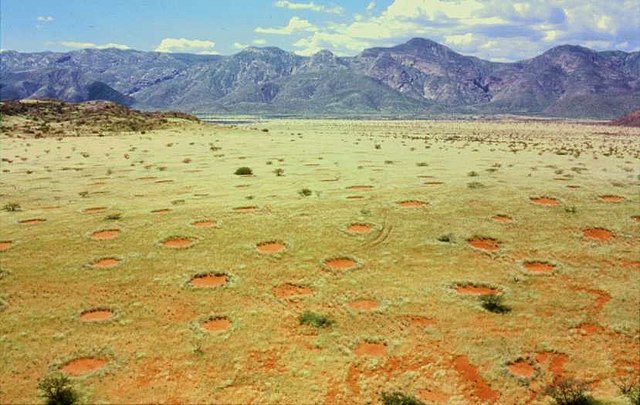 If you looked down at the Namib desert that stretches through Angola and Namibia you’d see something strange.
If you looked down at the Namib desert that stretches through Angola and Namibia you’d see something strange.
Circles in the sand, ringed with grasses. Pocked all over – fairy circles, they call it. Who made them? And why?
Fairy circles
The desert sand is red. And in a narrow belt of the Namib, it is patterned in circles: some big – almost 40 ft across, and some small – about 6 ft across. And all of them are surrounded by perennial grasses.
Grasses that are absent from the centers of the circles. So if you look at it from a height, you’d see grasses outlining perfectly circular barren patches. Scientists have for years wondered what might have caused these “fairy circles.”
The local Himba people pay these circles little mind. They believe that their ancestors made them – or, in some cases, call it the “footprints of the Gods.” But of course, neither of those theories will stand up to scientific proof. And so the scientists began to look for the real explanation.
The latest find
In a recently published study, scientists think they may have solved the mystery behind the fairy circles: termites.
Scientists have found evidence that a particular type of termite – one that does not build mounds and leaves no traces in the sand but lives underground, might be the culprit. Or the artist, depending on your point of view.
They believe that the termites chew on the roots of the grasses (desert grassroots go down quite deep) and kill the grasses, freeing the land from vegetation. When it rains the water then seeps down quickly into the soil and is not lost due to evaporation. Thus water “pools” in these pockets and enriches the periphery where grasses grow. The termites continue to chew on any new roots that try to establish themselves, thus keeping the inner part of the circle barren above ground.
Greening the desert
Without knowing it, the termites are actually greening the desert. How so? Unless the soil is porous and sandy like it is where the termites work, water cannot seep through. Plants on the outer boundaries of the circles are growing and being nourished only because of water seeping into the centers.
Moreover, the scientists found the termites right from the very beginning of a circle. So in chomping the roots, the termites begin and implement an ingenious scheme of inadvertently greening the desert!
And guess what?! These grasses are integral to the Himba people. Why? They graze their cattle, goats, and sheep on these grasses and even use the inner circles to corral the animals at night. Termites are enabling a whole ecosystem out there.






